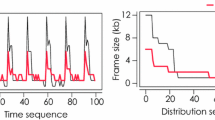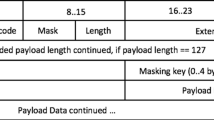Abstract
We are witnessing the unprecedented popularity of User-Generated-Content (UGC) on the Internet. While YouTube hosts pre-recorded video clips, in near future, we expect to see the emergence of User-Generated Live Video, for which any user can create its own temporary live video channel from a webcam or a hand-held wireless device. Hosting a large number of UG live channels on commercial servers can be very expensive. Server-based solutions also involve various economic, copyright and content control issues between users and the companies hosting their content. In this paper, leveraging on the recent success of P2P video streaming, we study the strategies for end users to directly broadcast their own live channels to a large number of audiences without resorting to any server support. The key challenge is that end users are normally bandwidth constrained and can barely send out one complete video stream to the rest of the world. Existing P2P streaming solutions cannot maintain a high level of user Quality-of-Experience (QoE) with such a highly constrained video source. We propose a novel Layered P2P Streaming (LPS) architecture, to address this challenge. LPS introduces playback delay differentiation and constructs virtual servers out of peers to boost end users’ capability of driving large-scale video streaming. Through detailed packet-level simulations and PlanetLab experiments, we show that LPS enables a source with upload bandwidth slightly higher than the video streaming rate to stream video to tens of thousands of peers with premium quality of experience.









Similar content being viewed by others
References
Cha M, Kwak H, Rodriguez P, Ahn, Y-Y, Moon S (2007) I tube, you tube, everybody tubes: analyzing the world’s largest user generated content video system. In: Proceedings of internet measurement conference
Huang C, Li J, Ross KW (2007) Can internet video-on-demand be profitable? In: Proceedings of ACM SIGCOMM
Hei X, Liang C, Liang J, Liu Y, Ross K (2007) A measurement study of a large-scale P2P IPTV system. IEEE Trans Multimedia 9(8):1672–1687
Liu F, Sun Y, Li B, Li B (2009) Quota: rationing server resources in peer-assisted online hosting systems. In: Proceedings of IEEE International Conference on Network Protocols (ICNP)
Liu J, Rao SG, Li B, Zhang H (2007) Opportunities and challenges of peer-to-peer internet video broadcast. In: Proceedings of the IEEE, special issue on recent advances in distributed multimedia communications
Gkantsidis C, Karagiannis T, Rodriguez P, Vojnovic M (2006) Planet scale software updates. In: Proceedings of ACM SIGCOMM
Chu Y-H, Rao SG, Zhang H (2000) A case for end system multicast. In: Proceedings of ACM SIGMETRICS
Castro M, Druschel P, Kermarrec A-M, Nandi A, Rowstron A, Singh A (2003) SplitStream: high-bandwidth multicast in cooperative environments. In: Proceedings of ACM SOSP
Venkataraman V, Yoshida K, Francis P (2006) Chunkyspread: heterogeneous unstructured end system multicast. In: Proceedings of IEEE International Conference on Network Protocols (ICNP)
Pai V, Kumar K, Tamilmani K, Sambamurthy V, Mohr AE (2005) Chainsaw: eliminating trees from overlay multicast. In: IPTPS
Zhang X, Liu J, Li B, Yum T-SP (2005) DONet/CoolStreaming: a data-driven overlay network for live media streaming. In: Proceedings of IEEE INFOCOM
Magharei N, Rejaie R (2007) PRIME: Peer-to-Peer Receiver-drIven MEsh-based streaming. In: Proceedings of IEEE INFOCOM
Zhang M, Zhang Q, Sun L, Yang S (2007) Understanding the power of pull-based streaming protocol: can we do better? IEEE J Sel Areas Commun 25(9):1678–1694
Wang F, Xiong Y, Liu J (2007) mTreebone: a hybrid tree/mesh overlay for application-layer live video multicast. In: Proceedings of IEEE International Conference on Distributed Computing Systems (ICDCS)
Jin X, Yiu W-PK, Chan S-HG, Wang Y (2007) On maximizing tree bandwidth for topology-aware Peer-to-Peer streaming. IEEE Trans Multimedia 9(8):1580–1592
Chen M, Ponec M, Sengupta S, Li J, Chou PA (2008) Utility maximization in Peer-to-Peer systems. In: Proceedings of ACM SIGMETRICS
Small T, Li B, Liang B (2007) Outreach: Peer-to-Peer topology construction towards minimized server bandwidth costs. IEEE J Sel Areas Commun 25(1):35–45
Cui Y, Xue Y, Nahrstedt K (2006) Optimal resource allocation in overlay multicast. IEEE J Sel Areas Commun 17(8):808–823
Liu Z, Shen Y, Ross KW, Panwar SS, Wang Y (2008) Substream trading: towards an open P2P live streaming system. In: Proceedings of IEEE International Conference on Network Protocols (ICNP)
Feldman M, Papadimitriou C, Chuang J, Stoica I (2004) Free-riding and whitewashing in peer-to-peer systems. In: PINS ’04: proceedings of the ACM SIGCOMM workshop on practice and theory of incentives in networked systems. ACM, New York, pp 228–236
Xie H, Yang YR, Krishnamurthy A, Liu Y, Silberschatz A (2008) P4P: provider portal for applications. In: Proceedings of ACM SIGCOMM
Wu D, Liu CLY, Ross K (2009) View-upload decoupling: a redesign of multi-channel p2p video systems. In: Proceedings of INFOCOM mini-conference
Wu C, Li B (2007) Strategies of conflict in coexisting streaming overlays. In: Proceedings of IEEE INFOCOM
Kumar R, Liu Y, Ross K (2007) Stochastic fluid theory for P2P streaming systems. In: Proceedings of IEEE INFOCOM
Wu C, Li B, Zhao S (2008) Multi-channel live p2p streaming: refocusing on servers. In: Proceedings of IEEE INFOCOM
Hei X, Liu Y, Ross K (2007) Inferring network-wide quality in P2P live streaming systems. IEEE J Sel Areas Commun 25(9):1640–1654
Ashwin CH, Bharambe R, Padmanabhan VN (2006) Analyzing and improving a bitTorrent network performance mechanisms. In: Proceedings of IEEE INFOCOM
Liu Y, Guo Y, Liang C (2008) A survey on peer-to-peer video streaming systems. J Peer-to-Peer Netw Appl 1(1):18–28
Ganjam A, Rao SG, Sripanidkulchai K, Zhan J, Zhang H (2009) On-demand waypoints for live P2P video broadcasting. J Peer-to-Peer Netw Appl 3(4):277–293
Li B, Xie S, Qu Y, Keung G, Lin C, Liu J, Zhang X (2008) Inside the new coolstreaming: principles, measurements and performance implications. In: Proceedings of IEEE INFOCOM
Liang C, Guo Y, Liu Y (2009) Investigating the scheduling sensitivity of p2p video streaming: an experimental study. IEEE Trans Multimedia 11(3):348–360
Author information
Authors and Affiliations
Corresponding author
Rights and permissions
About this article
Cite this article
Liang, C., Liu, Y. Enabling broadcast of user-generated live video without servers. Peer-to-Peer Netw. Appl. 5, 205–218 (2012). https://doi.org/10.1007/s12083-011-0102-x
Received:
Accepted:
Published:
Issue Date:
DOI: https://doi.org/10.1007/s12083-011-0102-x




